| Solar eclipse of July 10, 1972 | |
|---|---|
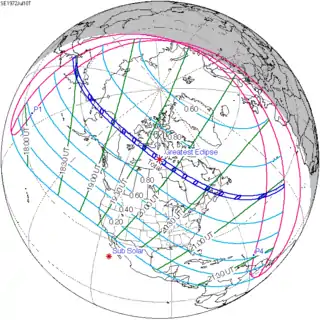 Map | |
| Type of eclipse | |
| Nature | Total |
| Gamma | 0.6872 |
| Magnitude | 1.0379 |
| Maximum eclipse | |
| Duration | 156 sec (2 m 36 s) |
| Coordinates | 63°30′N 94°12′W / 63.5°N 94.2°W |
| Max. width of band | 175 km (109 mi) |
| Times (UTC) | |
| Greatest eclipse | 19:46:38 |
| References | |
| Saros | 126 (45 of 72) |
| Catalog # (SE5000) | 9448 |
A total solar eclipse occurred on Monday, July 10, 1972. A solar eclipse occurs when the Moon passes between Earth and the Sun, thereby totally or partly obscuring the image of the Sun for a viewer on Earth. A total solar eclipse occurs when the Moon's apparent diameter is larger than the Sun's, blocking all direct sunlight, turning day into darkness. Totality occurs in a narrow path across Earth's surface, with the partial solar eclipse visible over a surrounding region thousands of kilometres wide. Occurring only 2.9 days after perigee (Perigee on July 7, 1972), the Moon's diameter was relatively large.
It was visible as a total eclipse along a path of totality that began in Sea of Okhotsk and traversed the far eastern portions of the Soviet Union (which now belongs to Russia), northern Alaska in the United States, Northern Canada, eastern Quebec and the Canadian Maritimes. A partial eclipse was visible over Siberia, Canada and the northern and eastern United States.
"You're So Vain"
The eclipse is referenced in the lyrics of Carly Simon's 1972 hit song "You're So Vain." The subject of the song, after witnessing his racehorse win "naturally" at the Saratoga Race Course, flies his Learjet to Nova Scotia to see the eclipse; Simon uses the two phenomena as examples of how the subject seems to be "where (he) should be all the time." Simon released the song four months after the eclipse.
Related eclipses
Eclipses in 1972
Solar eclipses of 1971–1974
This eclipse is a member of a semester series. An eclipse in a semester series of solar eclipses repeats approximately every 177 days and 4 hours (a semester) at alternating nodes of the Moon's orbit.[1]
Note: Partial solar eclipses on February 25, 1971 and August 20, 1971 occur in the next lunar year set.
| Solar eclipse series sets from 1971–1974 | ||||||
|---|---|---|---|---|---|---|
| Descending node | Ascending node | |||||
| Saros | Map | Gamma | Saros | Map | Gamma | |
| 116 |  1971 July 22 Partial | 1.51298 | 121 |  1972 January 16 Annular | −0.93651 | |
| 126 |  1972 July 10 Total | 0.68719 | 131 |  1973 January 4 Annular | −0.26441 | |
| 136 |  1973 June 30 Total | −0.07853 | 141 |  1973 December 24 Annular | 0.41710 | |
| 146 |  1974 June 20 Total | −0.82388 | 151 | 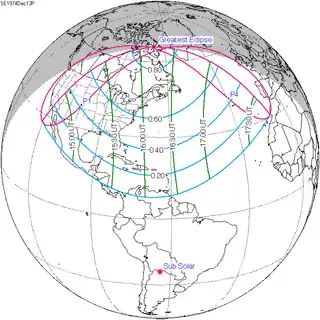 1974 December 13 Partial | 1.07974 | |
Saros 126
It is a part of Saros cycle 126, repeating every 18 years, 11 days, containing 72 events. The series started with partial solar eclipse on March 10, 1179. It contains annular eclipses from June 4, 1323 through April 4, 1810, hybrid eclipses from April 14, 1828 through May 6, 1864 and total eclipses from May 17, 1882 through August 23, 2044. The series ends at member 72 as a partial eclipse on May 3, 2459. The longest duration of central eclipse (annular or total) was 6 minutes, 30 seconds of annularity on June 26, 1359. The longest duration of totality was 2 minutes, 36 seconds on July 10, 1972. All eclipses in this series occurs at the Moon’s descending node.
| Series members 42–52 occur between 1901 and 2100 | ||
|---|---|---|
| 42 | 43 | 44 |
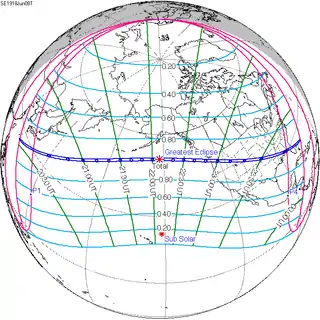 June 8, 1918 |
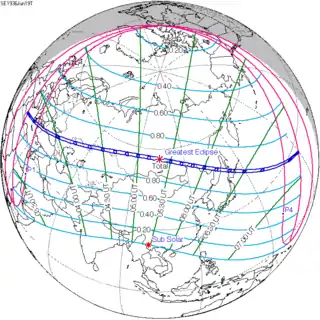 June 19, 1936 |
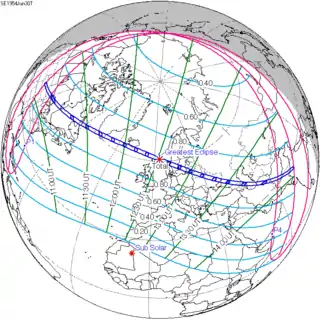 June 30, 1954 |
| 45 | 46 | 47 |
 July 10, 1972 |
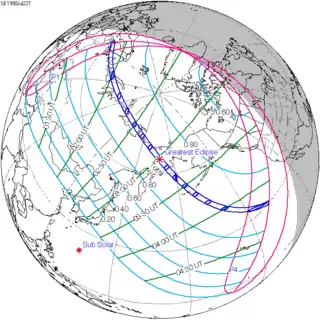 July 22, 1990 |
 August 1, 2008 |
| 48 | 49 | 50 |
 August 12, 2026 |
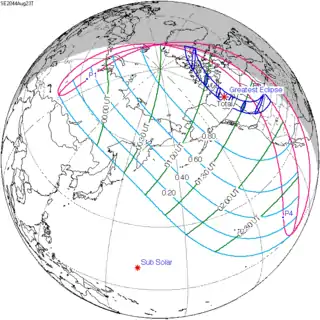 August 23, 2044 |
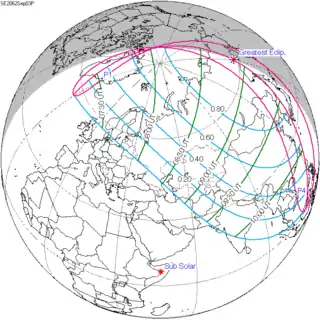 September 3, 2062 |
| 51 | 52 | |
 September 13, 2080 |
 September 25, 2098 | |
Metonic series
The metonic series repeats eclipses every 19 years (6939.69 days), lasting about 5 cycles. Eclipses occur in nearly the same calendar date. In addition, the octon subseries repeats 1/5 of that or every 3.8 years (1387.94 days). All eclipses in this table occur at the Moon's descending node.
| 21 eclipse events, progressing from north to south between July 11, 1953 and July 11, 2029 | ||||
|---|---|---|---|---|
| July 10–12 | April 29–30 | February 15–16 | December 4–5 | September 21–23 |
| 116 | 118 | 120 | 122 | 124 |
 July 11, 1953 |
 April 30, 1957 |
 February 15, 1961 |
 December 4, 1964 |
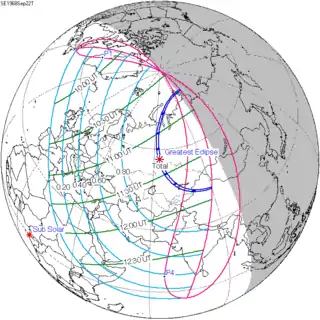 September 22, 1968 |
| 126 | 128 | 130 | 132 | 134 |
 July 10, 1972 |
 April 29, 1976 |
 February 16, 1980 |
 December 4, 1983 |
 September 23, 1987 |
| 136 | 138 | 140 | 142 | 144 |
 July 11, 1991 |
 April 29, 1995 |
 February 16, 1999 |
 December 4, 2002 |
 September 22, 2006 |
| 146 | 148 | 150 | 152 | 154 |
 July 11, 2010 |
 April 29, 2014 |
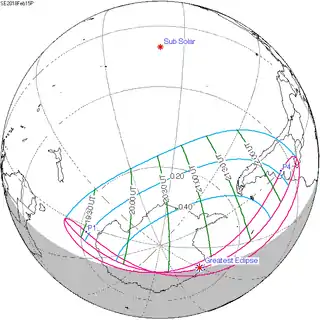 February 15, 2018 |
 December 4, 2021 |
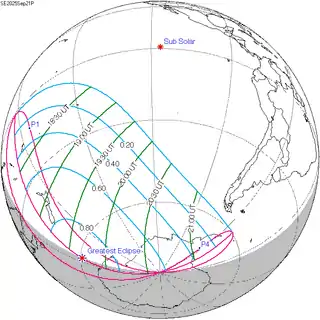 September 21, 2025 |
| 156 | 158 | 160 | 162 | 164 |
 July 11, 2029 | ||||
Notes
- ↑ van Gent, R.H. "Solar- and Lunar-Eclipse Predictions from Antiquity to the Present". A Catalogue of Eclipse Cycles. Utrecht University. Retrieved 6 October 2018.
References
- Earth visibility chart and eclipse statistics Eclipse Predictions by Fred Espenak, NASA/GSFC
- Foto solar eclipse of July 10, 1972 in Russia Archived August 8, 2009, at the Wayback Machine
- Foto solar eclipse of July 10, 1972 in Russia (2)
- Image solar eclipse of July 10, 1972
.jpg.webp)

